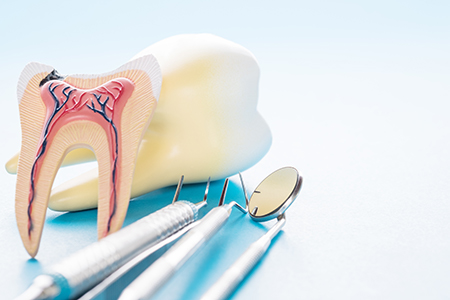Existing Patients
(515) 223-4194
New Patients
(515) 207-7409

Being told a tooth needs a root canal can feel alarming, but modern endodontic care is designed to relieve pain and preserve your natural smile with predictable results. Root canal therapy removes diseased tissue from inside a tooth, halts infection, and allows the remaining structure to be restored so you can chew comfortably and look your best.
At the dental office of Dr. Robert McNurlen and Dr. Austin Steil — Smiles for Life — we combine proven techniques with patient-centered comfort measures to make the experience straightforward and low-stress. Our goal is to keep your mouth healthy while protecting the long-term function and appearance of your teeth.
When a tooth’s inner tissues become inflamed or infected, extraction is not the only option. Root canal treatment removes the compromised pulp while preserving the outer tooth structure, which helps maintain proper bite alignment, chewing efficiency, and jawbone support. In most cases, a treated tooth can function for many years, often for a lifetime with proper restoration and care.
Advances in instruments, imaging, and materials have improved the accuracy and comfort of root canal therapy. Dentists can now navigate complex canal systems more efficiently and fill them with biocompatible materials that create a reliable seal. These refinements contribute to the high success rates patients expect from contemporary endodontic care.
Choosing to save a natural tooth when feasible also reduces the need for additional procedures later on. Replacing an extracted tooth with an implant or bridge involves its own set of considerations; preserving what you have is typically the least invasive route to long-term oral health.

Every tooth contains a central chamber filled with dental pulp — soft tissue made up of nerves, blood vessels, and connective tissue. The pulp helps teeth form and senses temperature and pressure. When decay, cracks, or trauma breach the protective enamel and dentin, bacteria can reach the pulp, causing inflammation or infection.
Symptoms vary. Some people experience sharp or lingering pain, heightened sensitivity to hot or cold, or discomfort when biting. Other times a tooth can darken in color or the nearby gum tissue can swell. Still, some infected teeth cause little or no pain initially and are detected on radiographs during routine exams.
Because the signs can be subtle or similar to other dental issues, a careful clinical exam and imaging help determine whether the pulp is injured, infected, or irreversibly damaged — and whether root canal therapy is the appropriate treatment to preserve the tooth.
Keep an eye out for these common indicators that a tooth may need root canal treatment:
Pain that persists or intensifies — especially pain that wakes you at night — often points to deep decay or pulp irritation. While not every toothache requires a root canal, persistent pain merits prompt evaluation to identify the underlying cause.
When hot or cold foods and drinks cause lingering discomfort, it can mean the pulp is inflamed. Mild sensitivity that subsides quickly is common, but prolonged reactions are a warning sign.
Sharp pain with pressure or tenderness to touch suggests that the tooth’s internal tissues are compromised or that an infection is affecting surrounding structures.
A tooth that darkens following injury or over time may indicate internal changes to the pulp. Discoloration alone isn’t definitive, but it often accompanies other signs of pulpal distress.
Structural damage can expose or traumatize the pulp, allowing bacteria to enter and infection to develop. Even hairline fractures may compromise internal tissues.
Gum swelling, a localized bump, or a recurring taste of drainage are red flags that an infection may be present and requires timely attention.
Advanced infection can affect the bone and periodontal support around a tooth, producing mobility. Treating the source of infection often stabilizes the tooth as healing occurs.

Some pulp problems become apparent only on X-rays before symptoms develop. Even if a tooth isn’t painful, radiographic changes or signs of spreading infection should be evaluated quickly. Delaying treatment can allow infection to advance, sometimes threatening adjacent teeth or weakening the jawbone that supports your dentition.
An untreated dental infection can lead to more complex procedures down the line, increased discomfort, and in rare circumstances, health complications beyond the mouth. Early diagnosis and appropriate therapy help limit these risks and preserve more of the natural tooth structure.
Regular dental exams and timely responses to new symptoms are the best strategy for catching pulp problems early and keeping restorative needs as conservative as possible.
Root canal therapy today is precise and patient-friendly. Most procedures are performed with local anesthesia so the treated tooth feels numb during the work. When needed, sedation options can be offered to help patients remain relaxed and comfortable throughout the visit.
The dentist will access the tooth’s inner chamber, gently remove inflamed or infected tissue, and carefully clean and shape the canals using specialized instruments. After thorough disinfection, the canals are sealed with a biocompatible filling to prevent recontamination. Advances in imaging and instruments improve the predictability of each step.
Some cases are completed in a single visit; others require two or more appointments depending on the tooth’s anatomy and the presence of active infection. Once the root canal is finished, the tooth typically needs a permanent restoration — often a crown — to restore strength and long-term function. At Smiles for Life we coordinate this plan so the tooth is protected and the restoration meets both functional and aesthetic goals.

After your appointment, numbness from the anesthetic can linger for an hour or two — avoid chewing or biting soft tissues until sensation returns. Mild soreness around the treated tooth is normal for a few days as surrounding tissues heal; over-the-counter pain relievers usually manage this effectively. If a prescription is issued, follow directions closely.
Antibiotics are recommended only when there’s evidence of spreading infection; if prescribed, finish the entire course. While a temporary filling is in place, the tooth may be more prone to fracture, so avoid hard or sticky foods and try to chew on the opposite side until you receive your permanent restoration.
Good oral hygiene and regular dental checkups are essential for long-term success. A properly restored and maintained tooth that has undergone root canal treatment can remain functional for many years. If you notice increasing pain, swelling, or any persistent concerns after treatment, contact the office so the care team can assess and address the issue promptly.
In summary, root canal therapy is a reliable way to relieve pain, eliminate infection, and preserve natural teeth when the pulp is compromised. If you suspect a problem or have questions about tooth pain, sensitivity, or a recent injury, contact us for more information and guidance on next steps.
A root canal procedure is the best way to save a tooth that has been damaged by decay or injury and preserve your natural smile. The alternative is an extraction and treatment to replace the tooth. While at times a tooth is non-restorable and an extraction is the only option, when possible, it’s best to try and save your natural tooth. With proper care, a tooth with root canal therapy can serve your smile well for many years to come.
Despite lingering myths from before the age of modern dental anesthesia and technology, having a root canal procedure today is as routine and comfortable as visiting the dentist for a filling. While the procedure is performed under local anesthesia with your tooth completely numbed, we can also discuss options in dental sedation.
Whether the symptoms of a dental infection subside after a course of antibiotics, a draining abscess provides you with some temporary pain relief, or a tooth with radiographic evidence of pathology has not yet developed symptoms, it’s essential, before an infection worsens or occurs, to have a root canal procedure performed. In this way, the tooth can be disinfected, filled, and sealed to protect your health and avoid further problems.
If you have sustained a dental injury, have a toothache, jaw pain, swelling, or are experiencing any other unusual and uncomfortable oral symptoms, contact our office immediately for care. Dental problems that have not been evaluated and treated can significantly worsen, producing more severe damage and consequences for the involved teeth, your oral health, and even your overall wellbeing. Once you get in touch with our office, our friendly and compassionate office team will get you in for care at your earliest convenience.
While some root canal procedures can be completed in one visit, others may involve 2 or 3 appointments. How long it takes depends on various factors, including active infection, the number of canals in the tooth, and the tooth’s location or anatomy.
With a success rate that exceeds 95%, root canal therapy remains the most effective procedure to save a tooth in which the inner vital tissues have been damaged. However, as with all healthcare procedures, there are a small percentage of cases where the teeth become symptomatic a second time. The good news is that many of these teeth can still be saved with root canal retreatment or a minor surgical procedure known as an apicoectomy.
The best ways to maintain a tooth with root canal therapy are to get the proper restoration required to rebuild and protect the tooth, maintain proper oral hygiene, and schedule appointments for routine dental checkups and care.
Saving a tooth with root canal therapy is a wise investment that, in the long run, is typically less costly and invasive than having the tooth extracted and replaced with a fixed bridge or implant. As far as the exact cost of care, it can vary depending on which tooth is being treated. Many dental insurance plans provide coverage for root canal therapy. At the office of Smiles for Life, we do our best to optimize your dental benefits and minimize your out-of-pocket expenses. Our staff will answer all your questions about the cost of care and discuss all your payment options.
At the office of Smiles for Life, we use the latest technology and most effective methods of care to provide precise and gentle care. Our reputation for excellence is based upon a consistent record of achieving successful treatment outcomes while providing prompt, stress-free, and convenient treatment for every type of dental need.